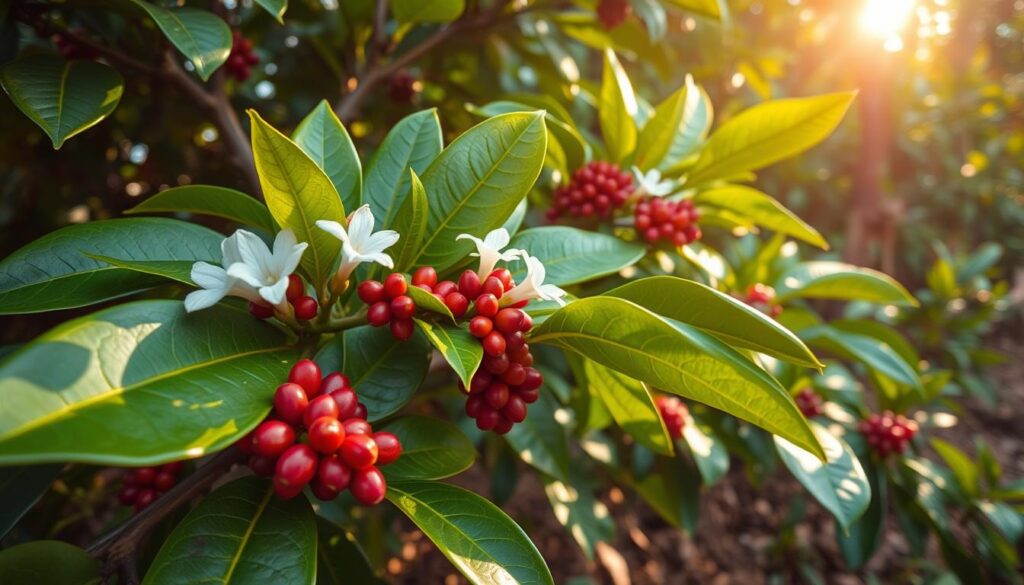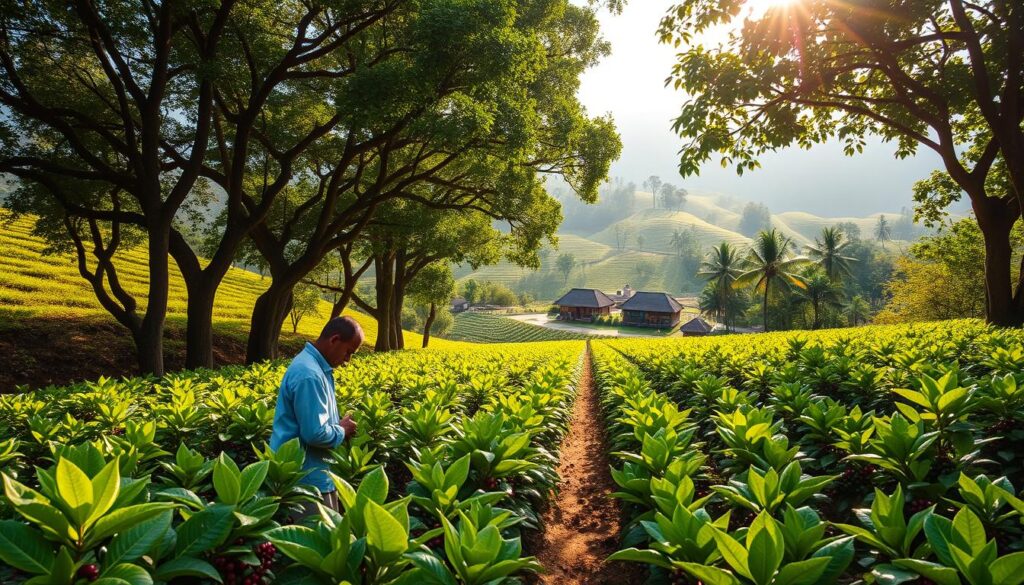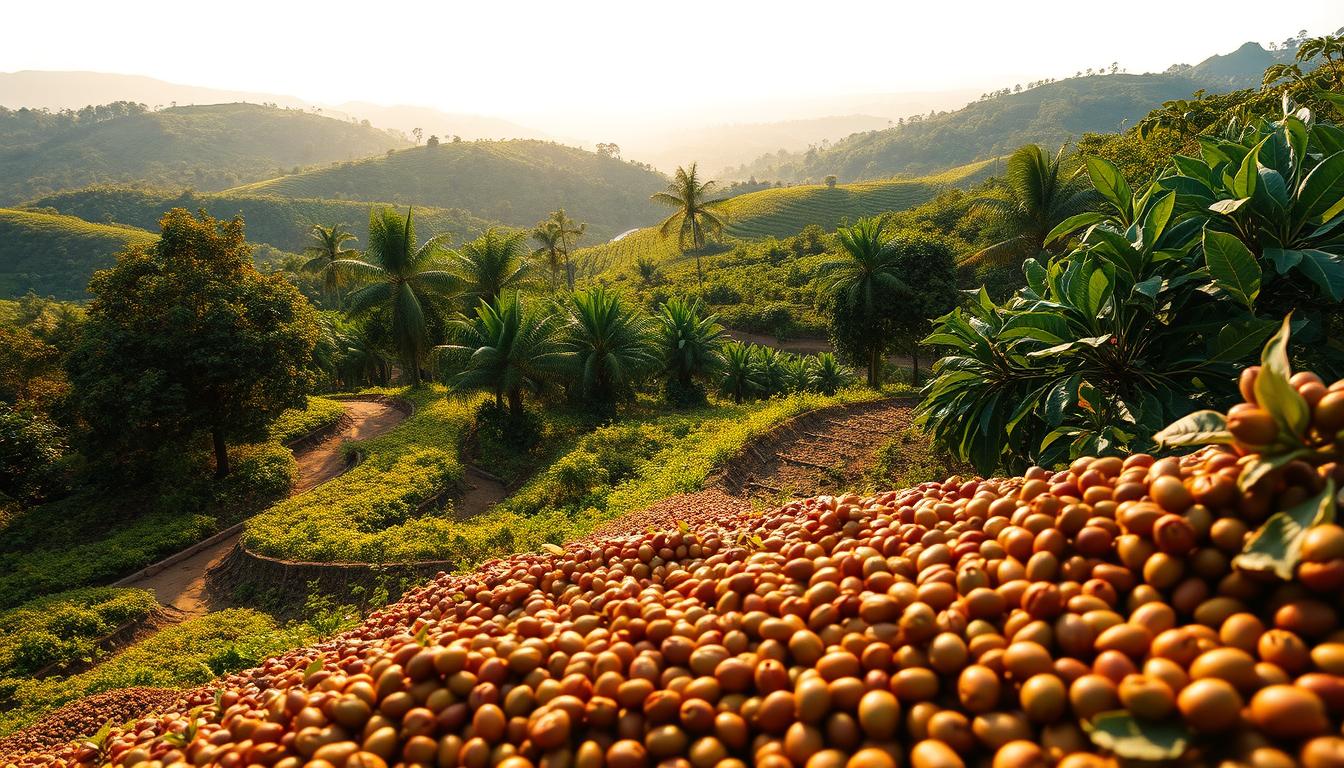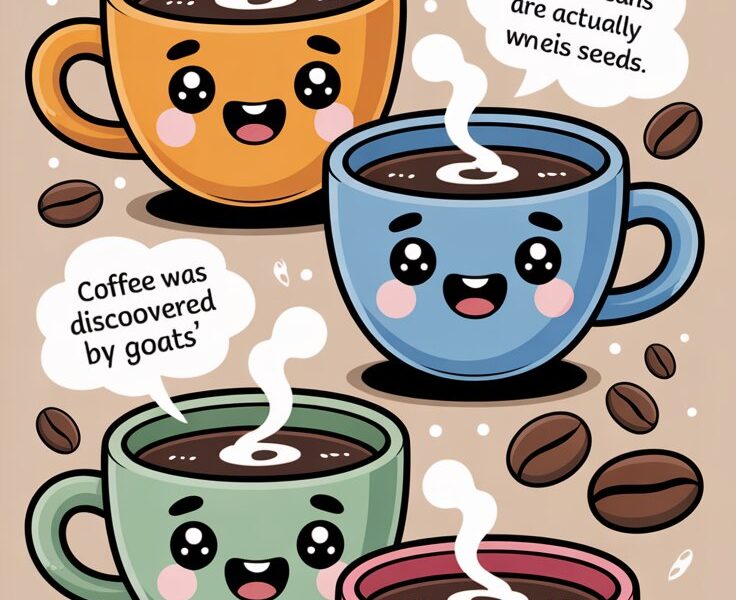What if your morning brew holds secrets older than your favorite café? That steaming cup in your hands isn’t just caffeine—it’s a global journey shaped by ancient legends, hardworking farmers, and cultural revolutions.
Centuries ago, Ethiopian herders noticed goats dancing after eating red cherries. This quirky origin story—Kaldi’s discovery—sparked humanity’s love affair with coffee. From Arabian monasteries to European cafés, beans became currency, fueling trade empires and sparking revolutions.
Today, your espresso connects you to three transformative waves of coffee history. Farmers battle climate shifts to grow beans, while roasters turn them into art. Yet few realize how soil quality, processing methods, and fair labor practices shape every sip.
Why does this matter? Your choices—whether grabbing a quick drip brew or savoring single-origin pour-over—support either mass production or ethical sustainability. The beans’ journey from tree to mug involves triumphs, struggles, and flavors waiting to be explored.
Key Takeaways
- Ethiopian herders first discovered coffee’s energizing effects through curious goats
- Arabia monopolized coffee trade for centuries before it spread globally
- Modern production balances flavor, sustainability, and fair wages for farmers
- Climate and soil directly impact bean quality and taste profiles
- Your purchasing decisions influence industry labor practices and eco-initiatives
The Origins and Early History of Coffee
Imagine a 9th-century Ethiopian shepherd spotting goats nibbling red cherries before bouncing with energy. This Kaldi legend—whether myth or fact—marks coffee’s first documented appearance. Locals soon brewed the cherries into “qahwa,” a energizing drink shared during spiritual rituals.
Arabian Innovation Shapes a Beverage
By the 15th century, traders carried coffee beans across the Red Sea. Yemeni monks perfected roasting techniques, creating a drink that kept worshippers alert during prayers. As coffee trade empires emerged, Mecca’s coffeehouses became hubs for exchanging ideas—and occasional bans by rulers fearing political debates.
Ottoman Refinement Fuels Global Spread
Turkish traders boiled crushed beans with spices, inventing thick, potent coffee. Istanbul’s first café opened in 1554, sparking a social revolution where people debated art and news over cups. Venetian merchants later smuggled beans into Europe, despite calls to label coffee “Satan’s drink” by skeptical clergy.
These early chapters show how climate, culture, and curiosity transformed wild cherries into history’s most influential beverage. Your morning ritual connects you to goat herders, Sufi mystics, and Renaissance thinkers who all shaped coffee’s journey.
From Coffee Plant to Bean – The Natural Journey
Ever wonder why your espresso tastes radically different based on its origin? The answer lies in altitude, rainfall patterns, and hands that transform fruit into your favorite beverage. Coffee plants demand specific conditions to thrive—a delicate dance between nature and human skill.

Where Flavor Takes Root
Arabica plants grow best at 2,000-6,000 feet elevation, where cool nights slow cherry maturation. This extended growth period allows complex sugars to develop. Volcanic soil in regions like Guatemala adds mineral richness, while Ethiopian highlands create floral notes through acidic earth.
Farmers monitor microclimates closely. “A temperature shift of 3°F can ruin entire crops,” notes a Colombian grower. Plants take 3-4 years to bear fruit, with precise harvesting windows determined by local rainfall cycles.
Three Paths to Your Cup
Post-harvest processing dramatically alters taste profiles. Check how methods compare:
| Method | Process | Flavor Profile | Best For |
|---|---|---|---|
| Natural | Sun-dried cherries | Berry-like, heavy body | Ethiopian blends |
| Washed | Fermented & rinsed | Bright acidity, clean | Central American roasts |
| Honey | Partial pulp removal | Sweet, syrupy texture | Specialty single-origins |
The coffee plant’s growth stages reveal why some bags cost more. Natural processing uses 90% less water than washed methods, supporting drought-prone regions. Each technique requires exact timing—over-ferment beans by 12 hours, and you’ll get vinegar notes instead of citrus.
Next time you sip, consider the journey: years of plant care, climate battles, and processing artistry in every drop.
The Untold Story Behind Your Daily Cup of Coffee
Did you know the first livestreamed object wasn’t a concert or sports event—but a coffee pot? In 1991, Cambridge researchers rigged a camera to monitor their break room brew, accidentally pioneering web streaming. This blend of caffeine and tech ingenuity mirrors coffee’s knack for sparking unexpected connections.

Secrets in Every Sip
Consider Kopi Luwak—the world’s priciest beans, partially digested by civets. While controversial, this Indonesian method shows how nature’s quirks shape flavors. Farmers now use humane cage-free practices, proving tradition and ethics can coexist.
“We plant shade trees to protect coffee from harsh sun—it’s like giving the plants sunscreen.”
Guardians of the Bean
Behind your morning cup, farmers battle climate extremes while preserving ecosystems. Over 75% of global coffee comes from smallholders like those shaping coffee’s journey to the. Their sustainable methods include:
| Practice | Impact | Certification |
|---|---|---|
| Composting pulp waste | Reduces methane by 60% | Rainforest Alliance |
| Intercropping with bananas | Boosts soil nitrogen | Fair Trade |
| Water-efficient processing | Saves 5,000 gal/acre yearly | Organic |
These efforts ensure your espresso supports ecosystems, not exploits them. Next time you taste caramel notes or floral hints, remember—it’s not just geography. It’s generations of care baked into every bean.
Coffee as a Cultural Catalyst
Your local coffee shop isn’t just serving lattes—it’s continuing a 500-year-old tradition of revolution and connection. Across continents and centuries, these spaces have sparked ideas that reshaped art, politics, and daily life.

Where Ideas Brewed Freely
Istanbul’s 16th-century coffeehouses buzzed with chess games and poetry readings. Called “schools of the wise,” they let people from all classes share thoughts over tiny cups. Venice’s Caffè Florian, opened in 1720, became Europe’s first permanent coffeehouse—a safe space for artists and rebels during strict censorship eras.
Europe’s Living Room
London’s 17th-century “penny universities” charged one cent for entry and endless refills. Students debated alongside scientists like Isaac Newton. Vienna’s Café Central later hosted Freud and Trotsky, proving caffeine fuels more than wakefulness—it ignites revolutions of thought.
Landmarks in Every Sip
Rome’s Antico Caffè Greco still displays art by Byron and Keats on its walls. Vienna’s Café Central once doubled as a post office for emperors. These spaces didn’t just serve drinks—they became time capsules of human progress.
“Coffeehouses taught us how to disagree politely—a skill we’re relearning today.”
Next time you order a cappuccino, remember: you’re participating in a ritual that’s shaped constitutions, novels, and scientific breakthroughs. Modern coworking spaces and bookshops with espresso bars? They’re just the latest chapter in coffee’s role as society’s glue.
Impact of Coffee on Society and Modern Lifestyle
Your morning brew does more than wake you up—it’s a health elixir in disguise. Packed with antioxidants like chlorogenic acid, coffee fights free radicals linked to aging and disease. Studies show moderate drinkers (3-4 cups daily) have lower risks of heart issues and Type 2 diabetes.

Brain Fuel and Daily Rhythm
Caffeine blocks adenosine receptors, keeping you alert. This isn’t just about staying awake—it sharpens focus during meetings and enhances memory recall. A Johns Hopkins study found caffeine improves problem-solving skills by 30% in sleep-deprived adults.
Your 10 AM coffee break? It’s science-backed. Workers who take caffeinated pauses report 22% higher productivity. Remote teams use virtual “coffee chats” to spark creativity, proving the ritual adapts to modern needs.
“Two cups daily provide more antioxidants than most fruits—it’s nature’s multitasker.”
| Benefit | Effect | Recommended |
|---|---|---|
| Antioxidants | Reduces inflammation | 3-4 cups/day |
| Cognitive Boost | Enhances focus | 100-200mg caffeine |
| Mood Support | Lowers depression risk | Morning + midday |
Balance is key. Over 400mg caffeine daily may cause jitters, so pair your habit with water and mindful sips. From Ethiopian ceremonies to Zoom meetings, coffee remains humanity’s favorite productivity partner—one thoughtful cup at a time.
Conclusion
Every sip you take is a bridge across centuries. From Ethiopian highlands to your kitchen counter, coffee carries a global legacy shaped by explorers, farmers, and innovators. Ancient rituals meet modern science in each cup—whether it’s a gas station brew or a meticulously crafted pour-over.
This journey matters. Those beans traveled through wars, trade bans, and climate challenges to reach you. Farmers nurture plants through droughts, while roasters experiment with methods like honey processing for richer flavors. Ethical choices you make today directly support these efforts.
Want to dive deeper? Explore how Ethiopian coffee practices influence global sustainability. Share stories about your favorite café discoveries or family brewing traditions. Every conversation keeps coffee’s history alive.
Remember: your daily ritual isn’t just about caffeine. It’s a nod to Sufi mystics, Venetian traders, and Costa Rican growers protecting ecosystems. Each cup holds more than flavor—it’s a living connection to humanity’s shared story.


